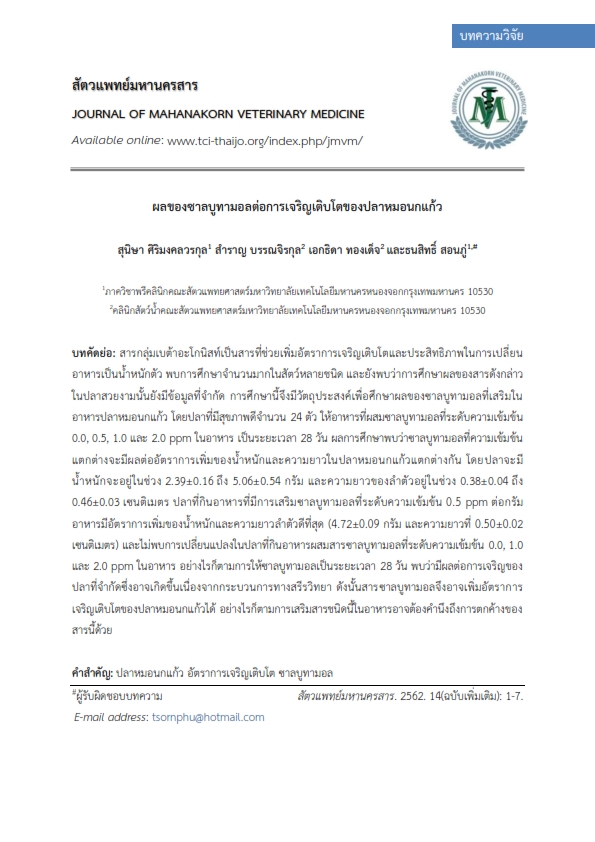Effect of Salbutamol on Growth Performances of Parrot cichild
Main Article Content
Abstract
β-agonists has been well documented for the ability to increase growth rate as well as improve feed efficiency in various species. However, there is limited information on use in ornamental fishes. The present study aimed to investigate the effect of salbutamol in fish feed. A total of 24 healthy Parrot cichlid were fed with test diets containing 0.0, 0.5, 1.0 and 2.0 ppm of salbutamol per gram of fish diet, respectively, for 28 days. The results showed that salbutamol had varying effects on growth parameters and body length ranged from 5.06±0.54 to 2.39±0.16 gram in weight and 0.46±0.03 to 0.38±0.04 in length. Among those, fish fed diet containing 0.5 ppm of salbutamol were improved growth parameters as well as the body length (4.72±0.09 g.; 0.50±0.02 cm.). Whereas, fish fed diets contained 0.0, 1.0 and 2.0 ppm was not markedly influenced by salbutamol supplementation. However, feeding salbutamol up to 28 days have limited effects on muscle growth may be due to physiological regulation. This study indicates that dietary supplemented with salbutamol could improve the growth of parrot cichlid. Therefore the information could be applied to the use of salbutamol as feed additive nevertheless veterinary drug residue could be considered.
Article Details
References
FDA. Freedom of information summary NADA 141-290 Topmax 9 (ractopamine hydrochloride). November 12, 2008. Available at: https://www.fda.gov/ downloads/animalveterinary/products/approvedanimaldrugproducts/foiadrugsummaries/ucm091516.pdf. Accessed: March 25, 2019.
FDA. Freedom of information summary NADA 141-258 Zilmax (zilpaterol hydrochloride). August 10, 2006. Available at: https://www.fda.gov/ downloads/AnimalVeterinary/Products/ApprovedAnimalDrugProducts/FOIADrugSummaries/ucm051412.pdf. Accessed: March 25, 2019.
Khirani, S., I. Dabaj, A. Amaddeo, A. J. Olmo, J. Ropers, S. Tirolien, V. Coudert, B. Estournet, B. Fauroux, and S. Quijano-Roy. 2017. Effect of salbutamol on respiratory muscle strength in spinal muscular atrophy. Pediatr. Neurol. 73: 78-87.
Liu, X., D. K. Grandy, and A. Janowsky. 2014. Ractopamine, a livestock feed additive, is a full agonist at trace amine–associated receptor 1. J. Pharmacol. Exp. Ther. 350(1): 124-129.
Moccia, R. D., R. M. Gurure, J. L. Atkinson, and G. W. Vandenberg. 2010. Effects of the repartitioning agen ractopamine on the growth and body composition of rainbow trout, Oncorhynchus mykiss, fed three levels of dietary protein. Aqua. Res. 41(11): 1582-1591.
Oliveira, L. M. F. S., R. S. Leal, T. C. Mesquita, M. E. S. G. Pimenta, M. G. Zangeronimo, R. V. Sousa, and R. R. Alvarenga. 2014. Effect of ractopamine on the chemical and physical characteristics of pacu (Piaractus mesopotamicus) steaks. Arq. Bras. Med. Vet. Zootec. 66: 185-194.
Satpathy, B. B., D. Mukherjee, and A. K. Ray. 2008. Effects of dietary inclusion of the beta-adrenergic agonist, salbutamol, on growth performance and whole body composition of rohu Labeo rohita (Hamilton) fingerlings fed diets containing two protein levels. Physiol. Rev. 88(2): 729-767.
Rønsholdt, B. and E. McLean. 2004. Effect of growth hormone and salbutamol on growth performance, fillet proximate composition and pigmentation of rainbow trout (Oncorhynchus mykiss). Aquaculture. 229: 225-238.
Tovo Neto, A., A. Correia Bittarello, R. Paulo Tovo, F. Meurer, L. Dena dos Santos, and R. Allan Bombardelli. 2017. Effect of ractopamine on Nile tilapia in the end of grow-out period. R. Bras. Zootec. 46(5): 367-373.
Xiong, L., Y. Q. Gao, W. H. Li, X. L. Yang, and S. P. Shimo. 2015. Simple and sensitive monitoring of β2-agonist residues in meat by liquid chromatographyetandem mass spectrometry using aQuEChERS with preconcentration as the sample treatment. Meat Sci. 105: 96-107.


